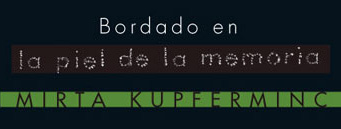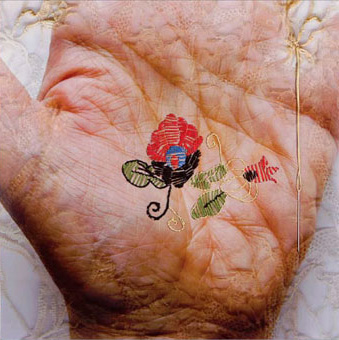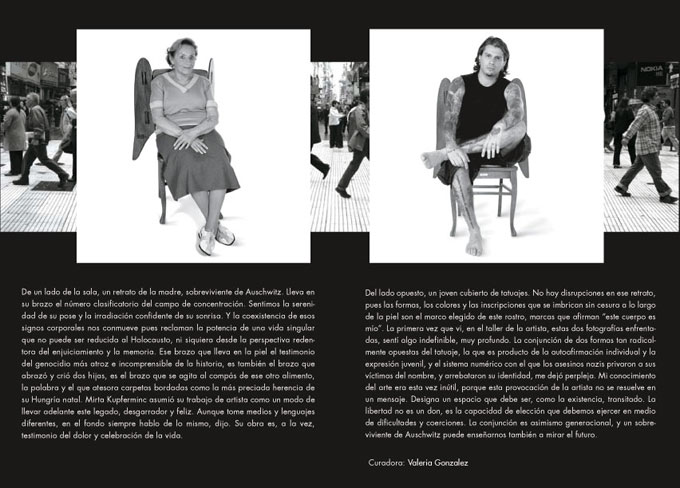The Skin of Memory
How does one rid oneself of something buried far within: memory and the
skin of memory. It clings to me yet.
Charlotte Delbo
Häftling: I have learnt that I am a Häftling. My number is 174517: we
have been baptized, we will carry the tattoo on our left arm until we die.
… Only much later, and slowly, a few of us learnt something of the
funereal science of the numbers of Auschwitz, which epitomized the
stages of destruction of European Judaism.
Primo Levi
The number tattoo is the predominant, perhaps even the singular
signifier of the Shoah. This one small part of the story of persecution,
humiliation and dehumanization - no more than a stage in the Nazi process of
genocide - has assumed the status of the very emblem of the event. This
perhaps because it makes permanently visible how prisoners were stripped of
their names, their identities, their past lives - how human beings were turned
into bureaucratic ciphers, Häftlinge. Survivors who have chosen to keep the
number “until they]die” do so to bear witness to their own victimization and
on behalf of those who have not survived to testify. Those who live with the
Auschwitz tattoo live inside bodies that are memorials and media of defiance.
Their arms are signposts alerting against the dangers of historical forgetting.
But how is the number tattoo seen and received? How does it intervene in our
present? How does it signify at a time when ornamental tattoos have become
ever more popular forms of bodily display, carrying very different kinds of
personal and cultural messages?
These are the questions that Mirta Kupferminc - a daughter of
Auschwitz survivors who grew up, as she says, “embraced by my parents’
tattoed arms” - raises in this memorial installation. Her parents could not hide
their traumatic past from their children: it was literally inscribed onto their
skin. And so their daughter also came to live inside the skin of memory.
But, with her artwork, she breaks out of this inherited trauma to provoke
us, as visitors, into an act of co-witness. We are invited to look at the two kinds
of tattoos, and to reflect on the differences between decorative choice and
coerced numbering. We are asked to stop within the flow of everyday life and
to sit, for a brief moment, on winged chairs that create a symbolic space of
remembrance and contemplation. Voices surround us in a constant murmur,
and if we just stop to listen, individual accounts of tattooing and being tattoed
reach our ears.
And then, something else is being asked of us as well, something more
troubling. Shall we extend our arm, offer it up to be marked? Will we get a
decorative design or a number? Who will determine which and by what logic?
And how, in the context of the memory of Auschwitz, can we live inside a
body that has been marked in this way, even for a transient moment?
Here the daughter artist is performing a daring provocation. Staging the
scene of the tattoo, she asks each of us to ponder what it might have been like,
had we been there. Is this empathy? Identification? Appropriation of the
trauma of the survivor? Those who respond to the call will have to decide for
themselves.
Marianne Hirsch & Leo Spitzer
|
|
|
|
La Piel de la Memoria
Cómo se libera uno de algo sepultado muy adentro: la memoria y la piel de la memoria. Persiste en mí, aún.
Charlotte Delbo
Häftling: He aprendido que soy un Häftling. Mi número es el 174517: hemos sido
bautizados y vamos a llevar el tatuaje en nuestro brazo izquierdo hasta nuestra muerte.
…Sólo mucho más tarde, y muy despacio, algunos de nosotros hemos aprendido algo
acerca de la ciencia funeraria de los números de Auschwitz, que resumieron las etapas
de la destrucción del judaísmo europeo.
Primo Levi
El tatuaje numérico es el significante individual predominante de la Shoah. Esta
pequeña parte de la historia de persecución, humillación y deshumanización – no más
que una etapa en el proceso nazi del genocidio – se ha tornado en emblema del evento.
Posiblemente porque hace permanentemente visible como los prisioneros fueron
despojados de sus nombres, sus identidades, sus vidas previas – cómo seres humanos
fueron transformados en cifras burocráticas, prisioneros. Sobrevivientes que han
elegido conservar el número “hasta su muerte”, lo hacen como testigos de su propia
victimización y por aquellos que no han sobrevivido para atestiguar. Quienes viven con
el tatuaje de Auschwitz, viven en cuerpos que son recordatorios y desafío. Sus brazos
son hitos que alertan contra el peligro del olvido histórico. ¿Pero cómo es el número
tatuado visto y recibido? ¿Cómo interviene en nuestro presente? ¿Qué significa en
momentos en que los tatuajes ornamentales se han convertido en populares formas de
exhibición corporal, presentando muy diversos mensajes personales y culturales?
Estos son los interrogantes que Mirta Kupferminc – hija de sobrevivientes de
Auschwitz que creció, como dice “abrazada por los brazos numerados de mis padres” –
presenta en esta instalación recordatoria. Sus padres no pudieron ocultar el pasado
traumático de sus hijas: estaba escrito en su piel. Y así la hija también llegó a vivir en la
piel de la memoria.
Pero, con su testimonio artístico, Mirta sale del trauma heredado para
provocarnos, como participantes, como co-testigos. Estamos invitados a mirar los dos
tipos de tatuaje y reflexionar acerca de las diferencias entre la elección decorativa y la
numeración coercitiva. Se nos insta a parar en el correr cotidiano y sentarnos, por un
momento, en una silla alada que crea un espacio simbólico de recuerdo y
contemplación. Voces nos circundan en un murmullo constante y, si nos detenemos a
escuchar, relatos individuales de tatuar y ser tatuado llegan a nuestros oídos.
Y luego, algo más nos es pedido, algo más dificultoso. ¿Debemos extender
nuestro brazo, ofrecerlo para ser marcado? ¿Recibiremos un diseño decorativo o un
número? ¿Quién determinará cual y con qué lógica? ¿Y cómo, en el contexto de la
memoria de Auschwitz, podemos vivir en un cuerpo que ha sido marcada de éste modo,
incluso en forma transitoria?
Aquí la hija artista realiza una osada provocación. Presentando la escena del
tatuaje, nos pide a cada uno que evaluemos como habría sido, si hubiéramos estado allí.¿Es esto empatía? ¿Identificación? ¿Apropiación del trauma del sobreviviente? Quienes
respondan a la convocatoria deberán decidir por sí mismos.
Marianne Hirsch & Leo Spitzer |




